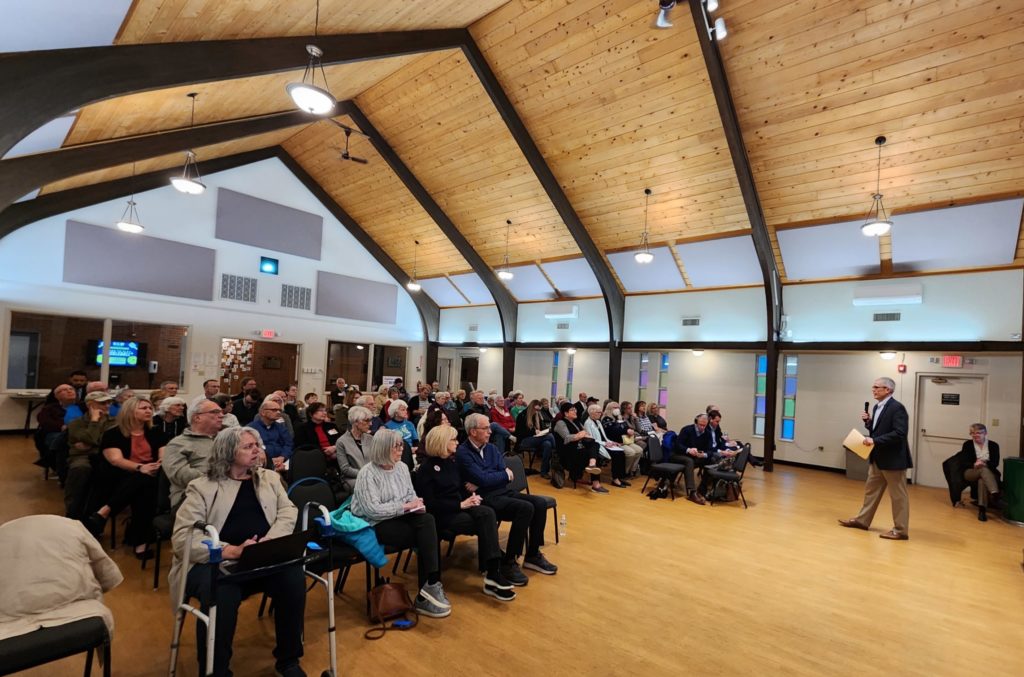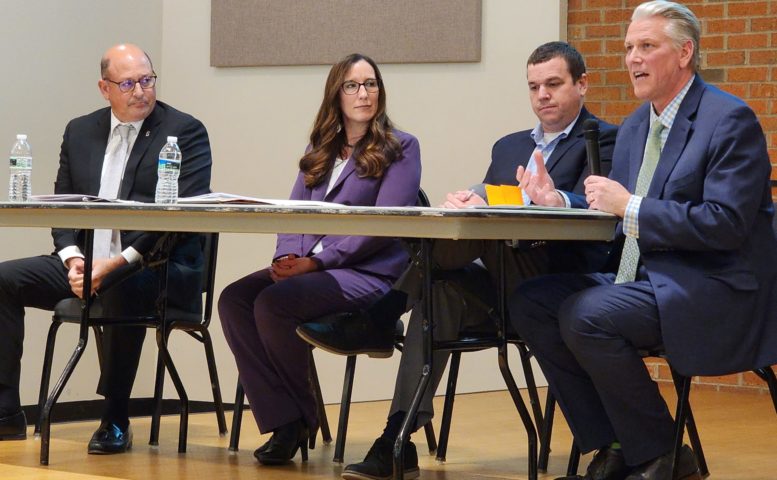By JAN LARSON McLAUGHLIN
BG Independent News
Local taxpayers were schooled Thursday on how much of the state’s education budget is being siphoned off to pay for private schools.
The public – and legislators – are in the dark about how it is spent, according to some local education officials. That’s because the public money being shifted by the state to private schools doesn’t undergo the scrutiny of public school spending.
It’s not just the spending – but also the scholastics that are confidential, since private schools avoid the public glare of state grade cards.
Ohio’s Constitution promises that public school funding must support “a single system of common schools,” but much of taxpayer money for schools has shifted in recent years to pay for charter and other private schools.
Since 2000, more than $25 billion in state funds have gone to vouchers and charter schools, according to the Ohio Coalition for Equity and Adequacy of School Funding.
On Thursday evening, the League of Women Voters of Bowling Green hosted a forum on public tax dollars subsidizing private schools. The program featured Perrysburg Superintendent Tom Hosler, plus panel members Springfield Superintendent Matt Geha, Sylvania Schools Treasurer Adam Koch, and Bowling Green City Schools Treasurer Cathy Schuller. The program was facilitated by BGSU teaching professor Todd Cramer.
While public schools are accountable to the public academically and fiscally, private schools are not. They don’t go through strict state audits and many don’t have to undergo rigid state testing of students.
Hosler explained there are three basic types of schools in Ohio – public, charter and private. And while many of the public school dollars are being shuffled to charter and private – the public schools are still stuck with the bill for transporting students in their districts to other schools in a 30-minute radius, and for providing the additional expenses of students with special needs.
“It’s a secret how schools are funded,” Koch said. “I don’t think the general public knows how much of their funding goes to private schools.”
“The legislators themselves don’t know it that well,” Geha said.
Public schools are accountable to the taxpayers, Schuller said.
“We have to account for every penny,” she said. “It’s on our website for everyone to see.”
Hosler, who believes there is value to some charter schools, said the public tax dollars should bring along responsibilities for accounting and academics.
“How are those dollars being spent? We don’t know. There should be some type of accountability and measurement,” he said. “Where are my tax dollars going? Are they going toward students’ education or fixing the church roof?”
Hosler, who attended the private St. Francis de Sales School in Toledo as a child, said he isn’t opposed to private schools. But he has a problem with taxpayer money being siphoned away from public schools to pay for them.
When his parents decided to send him to St. Francis, Hosler said they didn’t go knocking on their neighbors’ doors, saying, “We’d like you to help pay for that.”
“Parents have always had a choice,” Geha said.

Public education in Ohio has suffered for years with inadequate funding from the state – ruled as unconstitutional by the Ohio Supreme Court. After 20 years, an equitable funding system was set up, but implementation of it still lags.
“We just want a fair and equitable funding model,” Koch said.
But if the state legislature passes the proposed Backpack Bill, $1.16 billion in taxpayer money will immediately and annually go toward private and homeschool students.
In recent years, the state has passed off school vouchers as a way to help students escape failing public schools.
But a majority of the vouchers – using taxpayer money – are instead helping parents avoid paying tuition at private schools to “escape” from schools their children have never been enrolled in, according to the Ohio Coalition for Equity and Adequacy of School Funding.
Money for private school vouchers comes from the same pot of money intended for public schools. And as more money is shifted to vouchers, public schools are forced to beg for more money from taxpayers, or make cuts to jobs, benefits, pensions, and school programs.
And the numbers just don’t add up, public school advocates say. Under the voucher program, tax dollars pay private schools $7,500 for each high school student. Public schools, however, are paid just $1,100 from the state for each high school student.
Private school advocates have tried to tell Hosler that taxpayer dollars going to private schools will save public funds in the long run. “I’m not sure that math works,” he said.
Hosler addressed the “delicate seesaw” between state funding and local funding based on valuation of property in the district.
In Lucas County, eight private high schools annually received $493 more per pupil in public funds from the state than the public schools in the Northern Lakes League. Central Catholic received $6,105 per student a year, compared to $4,095 for Bowling Green City Schools and $3,330 for Perrysburg.
Meanwhile the public schools still need to provide transportation to the private schools – which in Perrysburg’s case is nine other schools. “That’s a challenge for us,” especially with the bus driver shortage, Hosler said.
Plus the public schools must continue to provide for students with special needs. Public schools don’t turn students away. “Every public school is proud of that,” Hosler said.
“Public schools accept every beautiful, wonderful child,” Geha said, adding that the costs to provide an education for some children with special needs can cost $100,000 over other children.
Bowling Green Board of Education last year joined more than 120 districts around the state in a lawsuit against the funding of vouchers with taxpayer money.
Bowling Green Board of Education member Ginny Stewart, who serves on the steering committee of Vouchers Hurt Ohio, stressed the long-range damage expected from siphoning off money from public schools.
“We believe the expansion of vouchers will destroy the public education system,” she said. In the last two years, the Bowling Green district has lost close to $500,000 in state funding that was shifted over to private schools, Stewart said.

